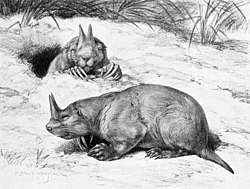Description
The 60 cm (2 ft) long creature is one of the oldest rodents known. It resembled a mouse and already had characteristic rodent incisors. Ischyromys's hind legs were longer than the forelegs, which could be used for other means than walking. Unlike most other mammals of its time, Ischyromys was probably arboreal (along with its relative Paramys ). It was a well-adapted climber that gradually beat out competition from rodent-like arboreal plesiadapiform primates. [1]
The brain of I. typus was characterised by an exposed midbrain. Additionally, it had less developed olfactory bulbs as compared to plesiadapiforms, suggesting that early rodents relied less on their sense of smell as compared to primatomorphs and their relatives. [2]
This page is based on this
Wikipedia article Text is available under the
CC BY-SA 4.0 license; additional terms may apply.
Images, videos and audio are available under their respective licenses.




